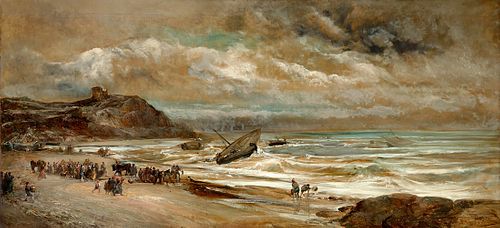RAMÓN MARTÍ ALSINA, (Barcelona, 1826 - 1894). "Accidentally returned from the fishermen". Oil on canvas. Signed in the lower right corner. With la
Lot 62
About Seller
Setdart Auction House
Carrer Aragó 346
Barcelona
Spain
Setdart Subastas was born in 2004 and is currently the first online art auction in Spain with solidity, prestige and reliability guaranteed by our more than 60,000 users. Setdart has a young, dynamic and enterprising team ready to successfully manage the purchase and sale of art works through custom...Read more
Estimate:
EUR€12,000 - EUR€15,000
$12,903.23 - $16,129.03
Absentee vs Live bid
Two ways to bid:
- Leave a max absentee bid and the platform will bid on your behalf up to your maximum bid during the live auction.
- Bid live during the auction and your bids will be submitted real-time to the auctioneer.
Bid Increments
| Price | Bid Increment |
|---|---|
| EUR€0 | EUR€10 |
| EUR€200 | EUR€25 |
| EUR€500 | EUR€50 |
| EUR€1,000 | EUR€100 |
| EUR€3,000 | EUR€200 |
| EUR€5,000 | EUR€500 |
| EUR€10,000 | EUR€1,000 |
| EUR€20,000 | EUR€2,000 |
| EUR€50,000 | EUR€5,000 |
About Auction
By Setdart Auction House
Oct 27, 2021
Set Reminder
2021-10-27 10:00:00
2021-10-27 10:00:00
America/New_York
Bidsquare
Bidsquare : 19th & 20th Century Paintings & Decorative Arts
https://www.bidsquare.com/auctions/setdart-auction-house/19th-20th-century-paintings-decorative-arts-7767
Setdart Auction House sofia@setdart.com
Setdart Auction House sofia@setdart.com
- Lot Description
RAMÓN MARTÍ ALSINA, (Barcelona, 1826 - 1894). "Accidentally returned from the fishermen". Oil on canvas. Signed in the lower right corner. With label on the back of Barrachina & Ramoneda. Size: 98,5 x 212 cm; 122 x 235,5 cm (frame). In this canvas Martí Alsina shows us one of his personal costumbrist seascapes, endowed nevertheless with an accurate dramatism that is reflected both in the human action of the ground plane and in the turbulent sky, of an almost baroque scenographic character, magnificently worked in several planes of depth, with thick bolted clouds, clearer in the base and raised like threatening waves, almost black in the upper right zone and open to a crepuscular sky in the central zone. In an asymmetrical and perfectly calculated composition, which reinforces the dramatic tension, we see a traditional scene starring the fishing boats that, dwarfed by the magnificence of nature, struggle to return to land without sinking, to the nervousness of their companions and families waiting on the beach. The dramatism of the scene is also wisely reinforced by the painter through the scale used, which dwarfs the characters before the grandeur of the natural scenery, more sublime if possible when he unleashes his fury. Considered today as the most important figure of Spanish realism, Martí Alsina is framed within the European avant-garde of the time. He revolutionized the Spanish artistic panorama of the 19th century, was a pioneer of the study of life and the creator of the modern Catalan school, as well as the master of a whole generation, with disciples of the importance of Vayreda, Urgell or Torrescassana. He began his studies in Philosophy and Literature, alternating them with night classes at the School of Fine Arts in Barcelona until 1848. Once he finished this first apprenticeship and decided to take up painting, he took his first steps in the Maresme region, where he began to earn his living by painting naturalistic portraits and landscapes in "plen air". In 1852 he became a teacher of line drawing at the Escuela de la Lonja in Barcelona, and two years later he began to teach figure drawing, a post he held until the accession to the throne of Amadeo de Saboya. In 1853 he traveled to Paris, where he visited the Louvre and became familiar with the work of Horace Vernet, Eugène Delacroix and French romanticism. Later he would become acquainted with the work of Gustave Courbet, the greatest exponent of realism. In 1859 he was appointed corresponding academician of the Academy of Fine Arts of Sant Jordi in Barcelona. His first important exhibition was the General Exhibition of Fine Arts in Barcelona in 1851. From that moment on he exhibited regularly in Barcelona, Madrid and Paris, and was invited to the Universal Exposition of the French capital in 1889. Among his prizes, the medals obtained in the National Exhibitions of Madrid stand out, third in 1858 with the work "Last day of Numancia" and second in 1860 with his landscape. In his last years he lived in seclusion, focusing his efforts on the search for new forms of expression, with a brushstroke close to impressionism. Among his themes we find numerous landscapes and seascapes, urban views (especially of Barcelona), portraits and human figures, genre scenes, temperamental female nudes, history painting and biblical scenes. On few occasions he dedicated himself to still life, although he also painted some of them. Works by Martí Alsina are preserved in the Prado Museum, the Thyssen-Bornemisza, the National Museum of Art of Catalonia, the MACBA, the Museum of the Abbey of Montserrat and the Museum of l'Empordà, in Figueras.
- Shipping Info
-
In-house shipping available. Please inquire at admin@setdart.com.
-
- Buyer's Premium



 EUR
EUR CAD
CAD AUD
AUD GBP
GBP MXN
MXN HKD
HKD CNY
CNY MYR
MYR SEK
SEK SGD
SGD CHF
CHF THB
THB


















